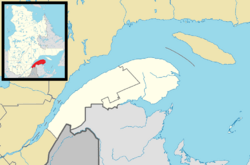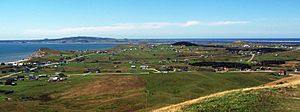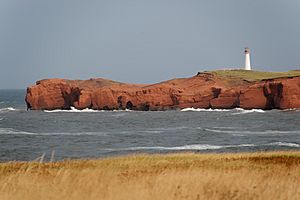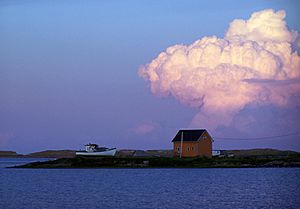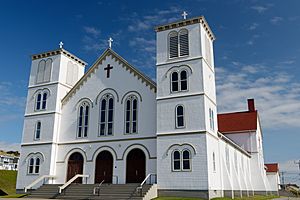Les Îles-de-la-Madeleine, Quebec facts for kids
Quick facts for kids
Magdalen Islands
Îles-de-la-Madeleine
|
|
|---|---|
|
Municipality
|
|
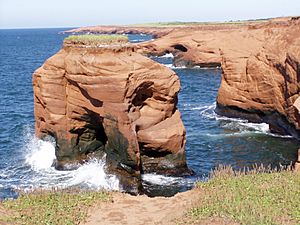 |
|
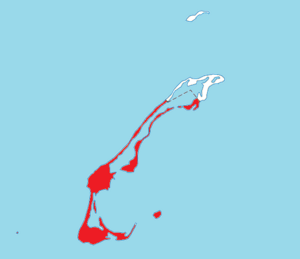
Location within Les Îles-de-la-Madeleine TE.
|
|
| Country | |
| Province | |
| Region | Gaspésie–Îles-de-la-Madeleine |
| RCM | None |
| Agglomeration | Les Îles-de-la-Madeleine |
| Constituted | January 1, 2002 |
| Area | |
| • Total | 33,704.00 km2 (13,013.19 sq mi) |
| • Land | 172.71 km2 (66.68 sq mi) |
| Population
(2016)
|
|
| • Total | 12,010 |
| • Density | 69.5/km2 (180/sq mi) |
| • Change 2011-2016 |
|
| • Dwellings | 6,223 |
| Time zone | UTC−4 (AST) |
| • Summer (DST) | UTC−3 (ADT) |
| Postal code(s) |
G4T 1A1
|
| Area code(s) | 418 and 581 |
| Highways | |
The Magdalen Islands (or Les Îles-de-la-Madeleine in French) are a group of islands in Quebec, Canada. They form a special type of local government called a municipality. About 12,010 people lived here in 2016.
The Magdalen Islands municipality was created on January 1, 2002. Seven communities on the islands joined together. Later, in 2006, one community called Grosse-Île decided to become separate again.
Exploring the Magdalen Islands' Communities
The Magdalen Islands municipality is made up of six communities that used to be separate towns. Each has its own unique story!
Grindstone: The Islands' Main Hub
Grindstone is located on Grindstone Island. People started living here in the 1800s. Even though it's a small area, it's the most important business center. Many call it the "Capital of the Islands."
The only way to reach the islands by sea is through the ferry that connects Grindstone to Souris, Prince Edward Island. The community's name comes from a quarry on the island where grindstones were found. In 2006, its population was 1,685.
Fatima: A Place of Faith
Also found on Grindstone Island, Fatima was settled between 1820 and 1845. It is named after Fátima in Portugal. That place is a famous pilgrimage site where many people visit. In 2006, Fatima had 2,809 residents.
Grande-Entrée: A Safe Harbor
Grande-Entrée is on Grand Entry Island. It's separated from the rest of the Magdalen Islands by the municipality of Grosse-Île. The name "Grande-Entrée" means "big entrance." It refers to the two pieces of land that face each other, creating a safe bay for boats.
Scots settled here in the late 1700s. However, Basque fishermen had visited the area much earlier, in the 1500s. Its population in 2006 was 624.
House Harbour: Home to the Airport
The first settlers arrived in House Harbour in 1765. They came from Acadia. This community is on House Harbour Island (Île du Havre aux Maisons in French). The island was once called Allright Island, then Saunders. This was after Sir Charles Saunders, a British admiral.
The harbor between Grindstone and House Harbour islands was known as Harbour Maison in 1756. The name "Maison" (meaning "house") might come from old ruins found by French explorers in 1663. These ruins were likely from early Basque visitors. In 2006, House Harbour had 2,078 residents.
The Îles-de-la-Madeleine Airport is located here. It is the only way to arrive on the Magdalen Islands by air. There's also a special windmill in the hamlet of Dune-du-Sud. It was built to test how power lines handle strong winds. Now, it's just a cool landmark!
L'Étang-du-Nord: A Fishing Hub
L'Étang-du-Nord is made up of several small villages. They are located along the eastern coast of Grindstone Island. This area became a main fishing center around 1830.
The community is also home to a campus of Cégep de la Gaspésie et des Îles. This is the only college-level school on the Magdalen Islands. In 2006, L'Étang-du-Nord had a population of 3,126.
Amherst: Islands with History
Amherst includes three different hamlets: Havre-Aubert, Bassin, and L'Île-d'Entrée. Havre-Aubert and Bassin are on Amherst Island (Île du Havre Aubert in French). L'Île-d'Entrée is on Entry Island (Île d'Entrée in French). In 2006, the population was 2,238.
The first settlers came to Amherst Island in 1762. They were from Acadia, Prince Edward Island, and the Chaleur Bay. Amherst Island is part of the "Most Beautiful Villages of Quebec."
Historians have different ideas about where the name "Havre-Aubert" came from. Some think it's named after an early explorer or a family of sailors. Others believe it might be from French explorer Jean-François Roberval. He might have named it "Havre au Ber" in 1542. "Havre" means harbor, and "ber" could mean "cradle."
Entry Island is unique because it's the only inhabited island in the Magdalen Islands not connected by land. It's about five kilometers east of Amherst Island. It is also one of the three English-speaking areas of the archipelago. Scottish and Nova Scotia settlers first lived here in the early 1800s.
Entry Island got its name because it sits at the southeast entrance of the islands. A ferry service connects Entry Island to the village of Grindstone.
Island Population and Languages
Who Lives on the Islands?
| Canada census – Les Îles-de-la-Madeleine, Quebec community profile | |||
|---|---|---|---|
| 2016 | 2011 | 2006 | |
| Population: | 12,010 (-2.3% from 2011) | 12,291 (-2.1% from 2006) | 12,560 (+2.3% from 2001) |
| Land area: | 172.71 km2 (66.68 sq mi) | 168.11 km2 (64.91 sq mi) | 168.11 km2 (64.91 sq mi) |
| Population density: | 69.5/km2 (180/sq mi) | 73.1/km2 (189/sq mi) | 74.7/km2 (193/sq mi) |
| Median age: | 52.2 (M: 52.1, F: 52.4) | 48.3 (M: 48.0, F: 48.6) | 44.7 (M: 44.3, F: 45.1) |
| Total private dwellings: | 6,223 | 5,924 | 5,607 |
| Median household income: | $61,029 | $52,220 | $47,539 |
| Notes: Municipality created on January 1, 2002. – References: 2016 2011 2006 earlier | |||
| Historical Census Data - Les Îles-de-la-Madeleine, Quebec | |||||||||||||||||||
|---|---|---|---|---|---|---|---|---|---|---|---|---|---|---|---|---|---|---|---|
|
|
||||||||||||||||||
|
|
|||||||||||||||||||
Languages Spoken on the Islands
Most people on the Magdalen Islands speak French. However, there are also communities where English is commonly spoken.
| Canada Census Mother Tongue - Les Îles-de-la-Madeleine, Quebec | ||||||||||||||||||
|---|---|---|---|---|---|---|---|---|---|---|---|---|---|---|---|---|---|---|
| Census | Total |
|
|
|
|
|||||||||||||
| Year | Responses | Count | Trend | Pop % | Count | Trend | Pop % | Count | Trend | Pop % | Count | Trend | Pop % | |||||
|
|
|
11,585 | 97.43% | 240 | 2.02% | 30 | 0.25% | 35 | 0.29% | |||||||||
|
|
|
11,850 | 97.29% | 270 | 2.22% | 35 | 0.29% | 25 | 0.20% | |||||||||
|
|
|
12,005 | n/a | 96.46% | 325 | n/a | 2.61% | 50 | n/a | 0.40% | 65 | n/a | 0.52% | |||||


